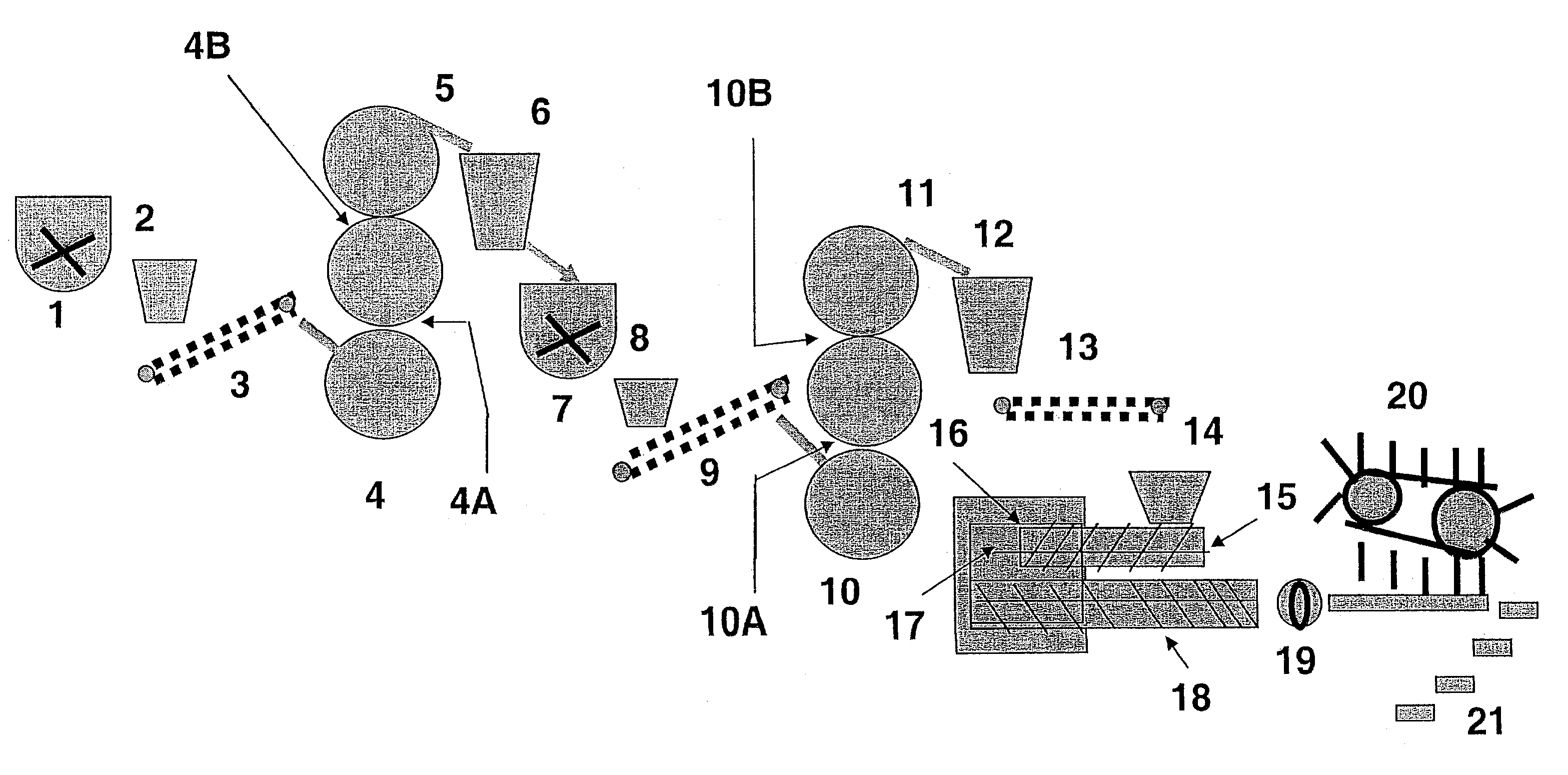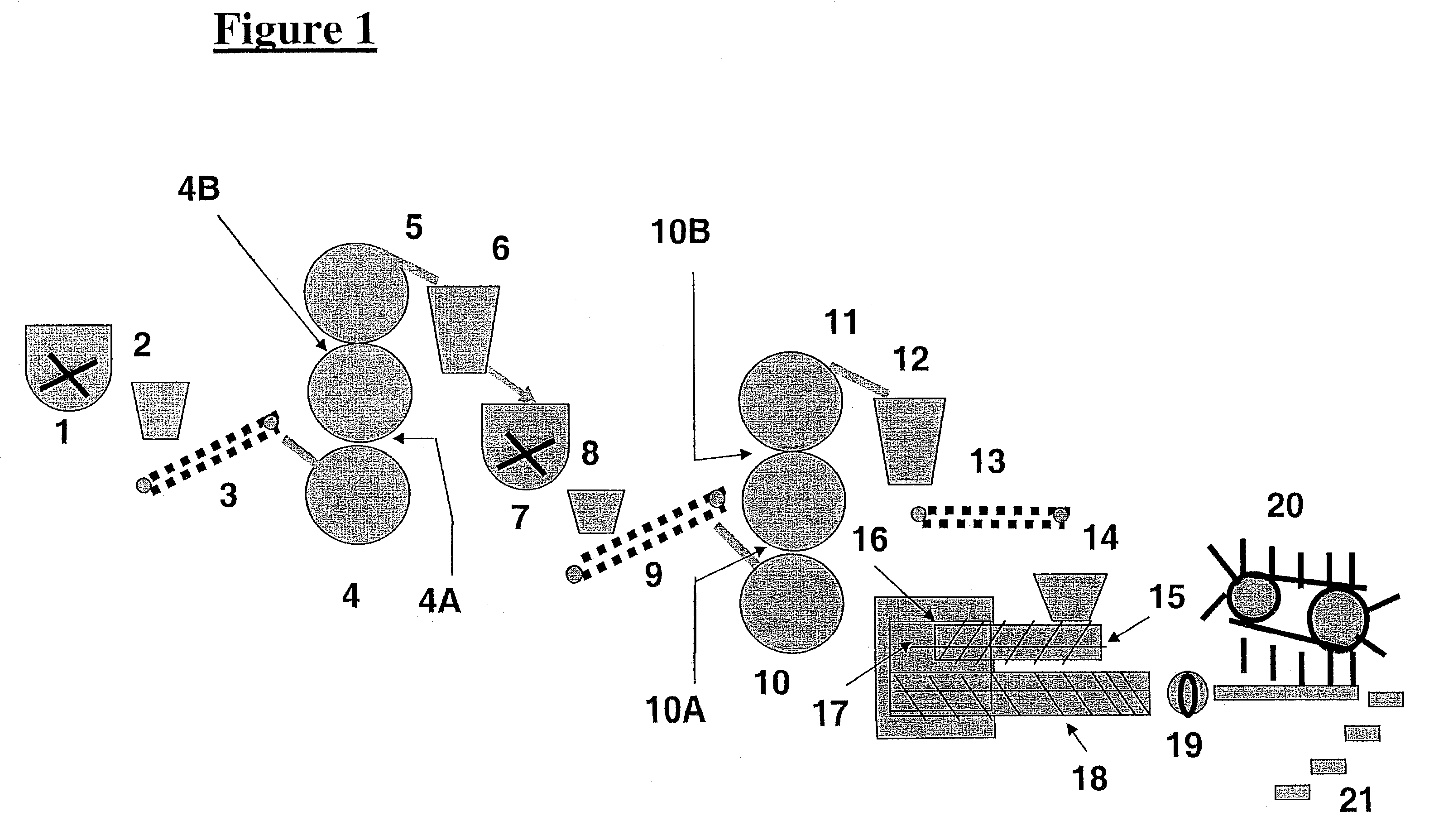Extruded stick product and method for making same
a technology of extrusion method and stick, which is applied in the direction of packaging foodstuffs, packaging goods, manufacturing tools, etc., can solve the problems of unsatisfactory achievement of previous attempts, and achieve the effects of reducing packaging costs, less expensive, and reducing the melting point of the formula
- Summary
- Abstract
- Description
- Claims
- Application Information
AI Technical Summary
Benefits of technology
Problems solved by technology
Method used
Image
Examples
example 1
Antiperspirant
[0073]The following organic ingredients were combined as powders and then milled (note that the same result can be achieved by extrusion, compression, pelletizing) using a three roll mill and passing the material through it three times: 25.00% stearyl alcohol, 10.00% castor wax, 8.00% polyethylene (MP-130 from Equistar Chemicals, L.P., Houston, Tex.). This results in a ribbon-like or flake intermediate form. The rest of the ingredients are then added to these ribbons and mechanically mixed. These include 22.25% antiperspirant active (REACH 36 trisalt from Reheis); 12.75% talc (Ultra Chemical, Redbank, N.J.); 14.50% cyclomethicone (DC 245 from Dow Corning, Midland, Mich.); 6.50% octododecanol; and 1.00% fragrance. Mixing can be a physical stirring, cutting, amalgamation (as in 1 and 7 in FIG. 1, or any other means that will bring all the ingredients into intimate contact with each other. This resulting mixture is milled as in 4 and 10 in FIG. 1 (again the same results c...
example 2
Antiperspirant
[0074]The method of Example 1 can be repeated using the following ingredients as the organics: 25% stearyl alcohol; 8% castor wax (MP 70 from Acme-Hardesty, Blue Bell Pa.); and 8% polyethylene. The remaining ingredients include 13.50% cyclomethicone (DC245); 5% C12–15 alkyl benzoate; 5% Fluid AP (a volatile silicone from Dow Corning); 22.00% antiperspirant active (REACH 36 trisalt from Reheis); 10.00% talc (Ultra Chemical); 2.5% petrolatum and 1.00% fragrance. It was found that the use of petrolatum and / or mineral oil was an inexpensive way of improving stick performance attributes such as payout / use-up and skin feel specifically.
example 3
[0075]In the manufacture of extruded deodorant formulations the following ingredients are combined as and then milled (note that the same result can be achieved by extrusion, pelletizing, compression) using a three roll mill and passing the material through it three times:
[0076]
80 / 20 Tallow / Coco Soap Chip46.50Propylene Glycol23.64Water13.97Diethylenetriamine Pentaacetic Acid-40%0.05Citric Acid-50% Solution0.4299% CP Glycerin for Toilet Articles4.8199% Triethanolamine0.84Distilled Coconut Oil Fatty Acids1.27Brine-25% Solution1.31Sorbitol-70% Solution7.19Total100.00
Soap pellets or flakes of an 80% tallow, palm oil, palm stearin or combination of these C16–C18 triglycerides and 20% coconut oil, palm kernel oil, palm kernel olein or combination of these lauric (C12) triglycerides, having a moisture level of 8%–25%, are combined with propylene glycol, 99% C.P. Glycerin, 99% Triethanolamine, Distilled Coconut Oil fatty acids, brine solution and 70% sorbitol in the amalgamators (1...
PUM
| Property | Measurement | Unit |
|---|---|---|
| Temperature | aaaaa | aaaaa |
| Percent by mass | aaaaa | aaaaa |
| Percent by mass | aaaaa | aaaaa |
Abstract
Description
Claims
Application Information
 Login to View More
Login to View More - R&D
- Intellectual Property
- Life Sciences
- Materials
- Tech Scout
- Unparalleled Data Quality
- Higher Quality Content
- 60% Fewer Hallucinations
Browse by: Latest US Patents, China's latest patents, Technical Efficacy Thesaurus, Application Domain, Technology Topic, Popular Technical Reports.
© 2025 PatSnap. All rights reserved.Legal|Privacy policy|Modern Slavery Act Transparency Statement|Sitemap|About US| Contact US: help@patsnap.com


